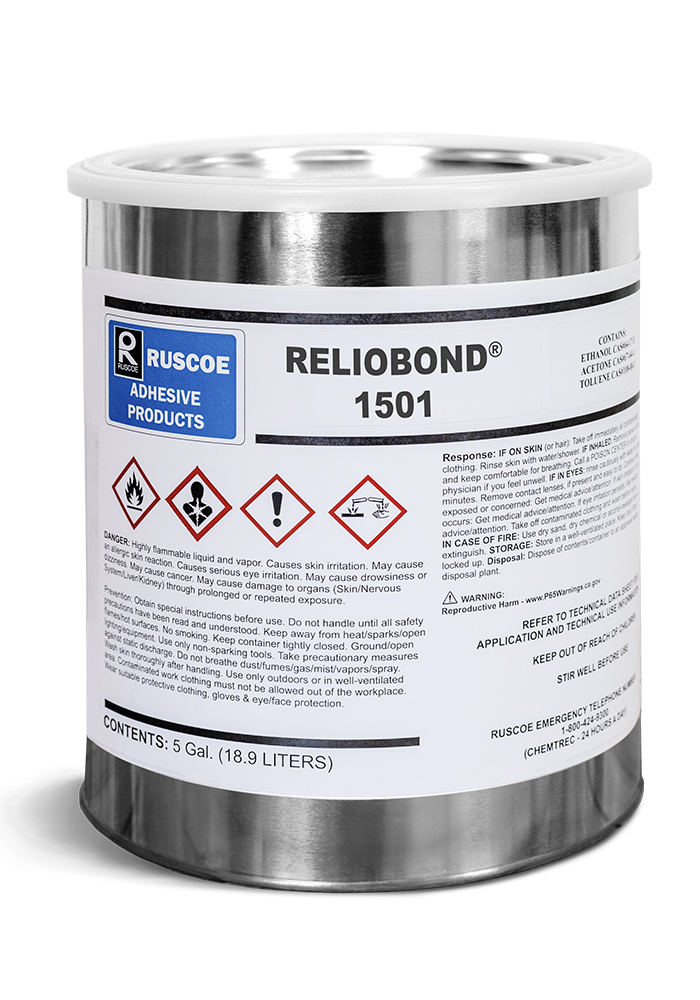Reliobond® 1501 Phenolic Friction Adhesive
Reliobond® 1501 is amber in color, economical, general purpose phenolic resin adhesive designed for bonding friction material to metal. This resin offers excellent bond strength across a wide range of temperatures, with resistance to oil, grease, transmission fluid and brake cleaning fluid.
SUGGESTED USES
Used heavily in brake, paper, clutch and transmission part applications.

All metal surfaces must be free of moisture, oils, dirt, and other contaminates. Typical cleaning processes include aqueous alkaline cleaners, solvent vapor cleaners, or burning or baking contaminates off the surface. After cleaning, a surface preparation process like phosphating, grit blasting, or wheel abrading will enhance the bond. RB1500 series products will bond very well to a clean, bare metal surface, but preparing the surface with one of these methods will improve the consistency and overall strength of the bond. Mix adhesive well before use. Reliobond® 1501 can be reduced to a desired viscosity/solids using a 60:40 blend of toluene and ethanol or methyl ethyl ketone or acetone in small quantities.
Apply to either the friction material or metal surface of the part. Depending on the application, dry film thickness of the coating can range from 0.5-5 mils. Due to variations in friction material density and composition and part size and configuration, experimentation is required to determine the optimal coating thickness. 1-3 mils of dry resin is a good starting point for most friction bonding applications.
DRYING
Coating must be fully dried before curing. Residual solvent in the coating can cause a weak, “spongy”, “blown” bond. Environmental conditions, coating thickness and drying equipment type all significantly affect dry time. Here are some general guidelines for drying:
- Drying oven temperatures can range from 100°F – 250°F. Do not exceed 250°F as higher temperatures can prematurely cure the adhesive or cause blistering of the adhesive film.
- Air flow in the drying oven is crucial to achieving fast dry times.
CURING
Phenolic resins generate water vapor during cure. This water vapor must be forced out of the coating using pressure during the cure cycle. Most bonding problems with this type of resin are related to inadequate or uneven pressure. At least 100 psi must be continuously and uniformly applied during the curing process to ensure a good bond.
Recommended cure temperature range is 300-450°F. Keep in mind that this is the temperature that the coating must reach, not the oven setting. Phenolic resins will cure slower at lower temperatures but will allow more time for water vapor to escape and for the coating to flow and wet the metal surface. Curing at too high of a temperature can cause the resin to gel quickly which will trap water vapor and cause a weak bond. Experimentation is required to determine the optimum cure cycle for each part design. A good starting point is to cure for 10-30 minutes at 400°F and 200 psi.
Reliobond® 1500 series adhesives are flammable and should be stored below 100°F (37.7°C) in tightly sealed containers away from direct sunlight, heat, sparks or other potential sources of ignition. Shelf life is 12 months from date of manufacture when stored appropriately. See Safety Data Sheet for more information on storage and disposal.
Health and safety data sheets available upon request at The Ruscoe Company.
Typical Properties:
| Color | Amber/Tan | |
| Solids, by Weight % | 30 – 34% | |
| Solvent Formulation | Acetone, Ethyl Alcohol, Toluene | |
| Viscosity, Brookfield, Spindle # | #4 | |
| Viscostiy, Brookfield, Test rpm | 20 rpm | |
| Viscoty, Brookfield, Test Result, CPS | 2,200 – 2,600 | |
| Pounds Per Gallon @77°F (25°C) | 7.8 | |
| Shelf Life | 12 Months |

